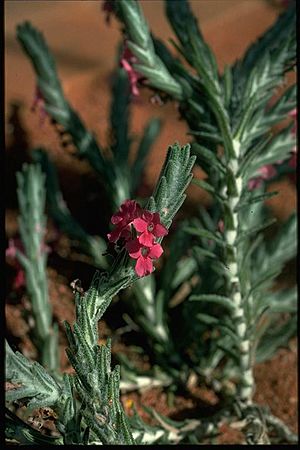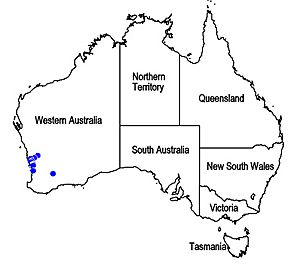Hemiphora uncinata facts for kids
Quick facts for kids Hemiphora uncinata |
|
|---|---|
 |
|
| Scientific classification | |
| Genus: |
Hemiphora
|
| Species: |
uncinata
|
 |
|
Hemiphora uncinata is a beautiful flowering plant that belongs to the mint family, called Lamiaceae. You can only find it growing naturally in the south-west part of Western Australia. This plant is a type of shrub that stands upright and spreads out. Its branches are covered with soft, white, woolly hairs. The leaves feel a bit rough and look wrinkled. Its flowers are shaped like tubes and are a lovely deep pink color, with petals that have wavy edges.
What it Looks Like
Hemiphora uncinata is a shrub that grows upright and spreads out. It usually reaches a height of 30–60 cm (10–20 in). Its branches are covered with white, soft, cotton-like hairs. The leaves are long and narrow, like a line or a spearhead. They are about 10–35 mm (0.4–1 in) long and 1–4 mm (0.04–0.2 in) wide.
The edges of the leaves often curve downwards or inwards. Many leaves have a small, hooked tip. The top surface of the leaf feels rough and looks wrinkled, with tiny bumps. The bottom surface is covered with woolly hairs, especially when the plant is young.
The flowers are a deep pink color. They grow either alone or in small groups of up to three. Each flower sits on a woolly stalk that is 2–4 mm (0.08–0.2 in) long. You'll find these flowers growing where the leaves meet the stem, which are called axils.
At the base of the flowers are special leaf-like parts called bracts. These bracts are 10–15 mm (0.4–0.6 in) long. They are smooth on the inside but very woolly on the outside. There are also smaller, smooth bracteoles.
The flower has five sepals, which are like small leaves that protect the bud. They are 6–8 mm (0.2–0.3 in) long and join together at their base to form a short tube. The sepals are woolly on the outside and stay on the plant even after the petals fall off.
The petals are 13–15 mm (0.5–0.6 in) long and join to form a wide tube. This tube is about 7–10 mm (0.3–0.4 in) long and 5–7 mm (0.2–0.3 in) wide at the top. The outside of the petal tube has soft hairs. The inside is smooth, except for a ring of dense hairs above the ovary.
The five petal parts form two "lips." The upper lip has two parts that are mostly joined together. The lower lip has three parts that spread out. All five petal parts have wavy or uneven edges. They are roughly circular, about 4–6 mm (0.16–0.24 in) across.
Inside the flower are four stamens, which are shorter than the petal tube. The two lower stamens are much longer than the two upper ones. This plant flowers in spring. The fruit is almost round, hairy, and has veins. It is about 2–3 mm (0.08–0.1 in) wide. Hemiphora uncinata looks similar to another plant called Hemiphora exserta. However, Hemiphora uncinata has short stamens that stay inside the petal tube.
How it Got its Name
This plant was first officially described in 1863 by a scientist named Nikolai Turczaninow. He gave it the name Chloanthes uncinata. His description was published in a science journal called Bulletin de la Société Impériale des Naturalistes de Moscou. He studied a plant sample collected by James Drummond.
Later, in 1870, George Bentham changed the name to Pityrodia uncinata. Then, in 2011, three scientists – Barry Conn, Murray Henwood, and Nicola Streiber – moved this plant, along with three others, from the Pityrodia group into the Hemiphora group.
The second part of its name, uncinata, is a Latin word. It means "hooked," which refers to the hooked tips on its leaves.
Where it Grows
You can mostly find Hemiphora uncinata in areas near the coast. These areas are located between the cities of Perth and the Murchison River in Western Australia.
There are also some separate groups of these plants. You can find them near Gairdner and between Hyden and Lake Cronin. These places are part of the Geraldton Sandplains and Swan Coastal Plain biogeographic regions. The plant likes to grow in sandy clay soils in low areas. Sometimes, these areas can even get flooded in winter.
Conservation Status
The Western Australian Government's Department of Parks and Wildlife has classified Hemiphora uncinata as "not threatened." This means it is not currently at risk of disappearing.

